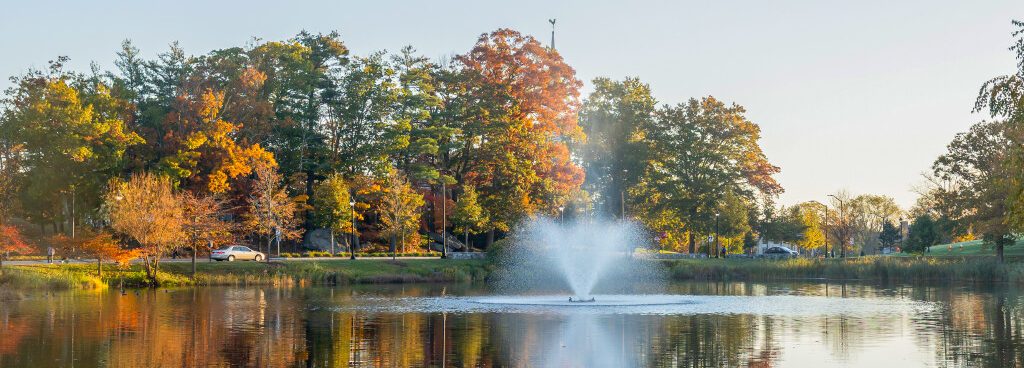
Water
Water conservation and usage at UConn
Read more about water conservation and usage at UConn!
The University of Connecticut recognizes that water is important, and inherently understands that its campus wide community depends on water. Still, it is easy to forget why conserving water is so important when it is readily available, but one must understand that people are not the only ones who depend on water. As an essential part of the natural environment, it is important to remind ourselves that the water we use today is water that someone, or something, may not be able to use tomorrow.
Conservation Throughout the Community:
Residential Assistants
RA's have a unique position and role to pass on important information about the working of the University and dorm life to all UConn residents. To improve outreach on major environmental initiatives here at UConn, it is important that the RA's have access to a range of current information and updates.
- Compile outreach materials for RA's including online packets, brochures, pre-made monthly bulletin boards, door knob hangers, and other materials to post in dormitories and/or present at floor meetings. Resources can be found here.
- Collaborate with Hall Directors to develop and implement RA in-service project development on environmental literacy among residents and promoting water conservation practices
- Develop inter-campus competitions utilizing water metering data to measure changes in water usage in each building.
Residents
UConn student residents also play an important role in the overall use of our resources, and it is important that all residents have access to educational information about how the student community can impact resources such as water. Friendly reminders and informational signage are established to make this outreach effort.
- Developed and broadcasting Public Service Announcements for DRL HuskyVision channel on water conservation in dormitories
- Implement "Stop the Drop!" signage and other informational signage at sinks and showers, as well as in laundry rooms
- Incorporate signage into residential areas through RA/ResLife environmental education materials
- Encourage standardized system for reporting leaks and malfunctions in plumbing and continue to provide appropriate contact information
Student Organizations
The student body is always busy, and part of the excitement of being at a University is the opportunity to join student groups and organizations. For those students interested and involved with relevant activities or initiatives, a strong support and communication among the student organizations is critical. Often times, we hope to help build collaboration and group efforts to promote important initiatives on campus.
- Collaborate with SWCS, Wildlife Society, and other student organizations to promote activities or events to communicate water conservation to peers
- Utilize meetings to brainstorm signage designs and locations, gather volunteers for outreach events, and reflect on results from outreach campaigns
Administration
The administration, faculty, and staff of the University are no less important. Their participation in outreach efforts and conservation programs serve as an important role model and support for these programs.
- Utilize other local media to inform community and administration on current actions and initiatives, as well as the progress made during these efforts; promote positive PR "conscious community" image to locals and students
- Inter-departmental collaboration on areas of improvement and general conservation practices- example: Department of Engineering publication distribution on Water Conservation Tips to UConn community and outreach to peer institutions abroad.
- Letters to the Editor or articles in Daily Campus on current events related to water conservation
- WHUS and other broadband announcements on current water conservation initiatives and improvements
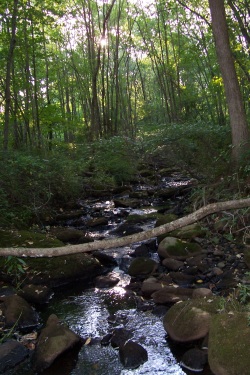
The University began preparing the Water Supply Emergency Contingency Plan following concerns about the University’s impact on local rivers; especially during low-precipitation periods. In February 2007, UConn sent the draft plan to the CT Water Planning Council. The plan identifies key areas in which the University and the local community can improve water conservation efforts throughout the year, as well as outlines specific responses for all water users during various levels of drought conditions.
The Water Supply Emergency Contingency Plan also specifically lists action plans for consumption areas ranging from voluntary water conservation practices to mandatory reductions and usage bans, depending on the priority use of water and drought conditions. These responses are based on the USGS station flow rate measure of the Fenton River. Specifically, the pumping of the Fenton River wells is scaled back depending on the response stage. This comes directly from the Fenton River Study completed in March 2006.
Some of these restricted uses include water use from: fire hydrants, irrigation, dust control, industrial cleaning and cooling practices, residential and municipal cleaning practices, water main testing and flushing, refilling pools, and washing vehicles.
Finally, the Water Supply Emergency Contingency Plan details a recovery action plan depending on the trigger level of the water emergency. This section describes the time period and expected recovery levels required to remove the emergency level alert for the University and community.
The University of Connecticut is allowed to draw approximately 844,300 gallons of water a day from its well fields near the Fenton River and approximately 2.3 million gallons from the Willimantic River well fields. On average, the University Water Supply System supplies 1.3 million gallons of water per day to UConn students, administration, faculty, staff, and community members.
From September 9-15 in 2005, about a 1/4 mile stretch of the Fenton River ran dry. In response to this event, the following statement was made to the DEEP:
As a result of this correspondence and concern, the University of Connecticut committed to restocking 1000 catchable size brown trout in the Fenton River, promoting greater public access to UConn-owned property for fishing along the Fenton River, conducting a study about re-colonization of invertebrates, and reimbursing the DEEP for natural resources lost and staff time spent during the investigation.
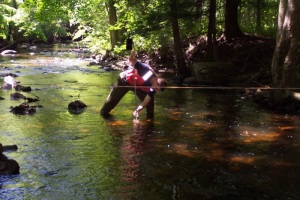
UConn Responsibilities
- Hire an expert water conservation consultant to assist the University in identifying and implementing additional conservation measures
- Implement the Water Conservation Outreach, Education, and Awareness Plan developed by the University's Environmental Policy Advisory Council Water Conservation workgroup
- Complete campus-wide water supply sub-metering program to enable real-time, on-line monitoring of water use in specific buildings, for the purposes of verifying conformance with conservation measures and measuring reduced demand achieved through conservation.
Water Supply System Assessment and Improvement
- Implementing improvements to the infrastructure in UConn's Willimantic River well field to increase capacity by 250,000 - 300,000 GPD
- Bringing the capacity of the Willimantic River well field to 1.5 million GPD collectively
- Reducing reliance on the Fenton River well field during periods of low flow and high demand
- Complete the Fenton River In stream Flow and Aquatic Habitat Study whcih includes management recommendations for minimizing impact on the river by Fall 2005 and seeking opportunities for review and comment on the final draft report by the Fenton Study Technical Advisory Group (TAG).
- Analyze the existing water distribution system including the condition of existing mains and areas at risk for significant water losses
- Pursue the terms of a pending DPH consent order and engage a professional operator to manage UConn's Water Supply System
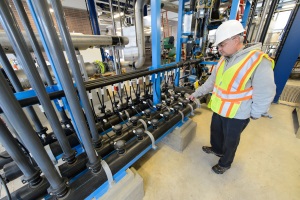
The Reclaimed Water Facility uses a tertiary treatment process for the University’s waste water. This process uses microfiltration and ultraviolet disinfection, which will allow UConn to divert a maximum of 1 million gallons of non-potable – not drinkable – water each day to meet the campus needs that don’t require fresh water. One of these needs is the CoGen power plant, which uses anywhere between 250,000 and 450,000 gallons of cooling water per day. The facility allows the University to use the treated non-potable water to meet this need instead, replacing the need to pump and treat hundreds of thousands of gallons of potable water from our two major water supply well fields. The Reclaimed Water Facility is currently fully operational and processes hundreds of thousands of gallons of water each day.
Learn more about the Reclaimed Water Facility from Facilities Operations
In 2011, UConn began construction of an on-site reclaimed water facility which is needed to reduce demand for potable water on the system and enable responsible growth of the campus and town. In recent years, UConn has conducted "instream flow" studies, which have shown that pumping of our water supply wells during drought periods can exacerbate low flow conditions in the two rivers near our wellfields. Thus, in addition to a formal drought response plan with voluntary and mandatory water conservation measures, UConn decided to take the next step and construct this $30 million Reclaimed Water Facility. The facility provides tertiary treatment of effluent from the University's adjacent sewage treatment plant and pumps the reclaimed water directly to our central utility plant/cogen facility, for use as cooling water, and to certain athletic fields, for irrigation purposes.
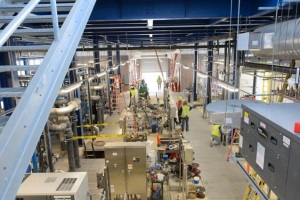
Awards
The University of Connecticut was awarded the Engineering Excellence Award by the American Council for Engineering Companies in April, 2010 for the reclaimed water facility's water reuse and engineering services. It was also awarded the 2011 Institution of the year award by the Water Reuse Association at the 26th annual WateReuse Symposium for its innovation in establishing the first industrial water reuse project in Connecticut and providing a tangible lesson to students on living sustainably. For more information about these awards, please click here.
News and Other Media
- Reclaimed Water Facility Brochure
- Eye on Sustainability: UConn Reclaimed Water Facility Shows Campus' Green Side - UConn Today, 9/22/16
- UConn, DEEP Officials Celebrate Opening of Water Reclamation Facility - UConn Today, 7/10/13
- Reclaimed Water: A Green Leap Forward - UConn Today, 10/13/10
When you fill up a BPA-free, reusable water bottle at the tap, or one of UConn's drinking fountains or hydration stations on campus, instead of buying bottled water, you're not only saving money but also reducing your ecological footprint and helping UConn become a more sustainable campus.
To request the installation of a hydration station, please submit a work order specifying your request. Departmental funds must be available to cover the cost of purchase and installation.
UConn's hydration or refill stations can be found across campus with more locations on the way. Currently, students, staff, and faculty can conveniently refill their bottles at over 60 locations:
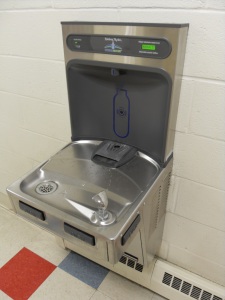
- Student Union (2)
- Facility Operations Building (2)
- Field House (2)
- Engineering II Building
- Budds Building
- Ellsworth Hall
- Fenwick Hall (Towers)
- Hale Hall
- Young Building (2)
- Whitney Hall
- Hilltop Community Center
- McConaughy Hall
- LaFayette Hall (Towers)
- Stamford Downtown Campus
- Eddy Hall (Alumni)
- Belden Hall (Alumni)
- Central Warehouse Building (Purchasing)
- Shippee Hall
- Family Studies
- Monteith Building
- Brock Hall
- Ryan Refectory Building (CHIP)
- Rome Hall
- Rowe Center (2)
- Buckley Residence Hall
- Electrical Shop
- McHugh Hall
- Batterson Hall
- North Residence Hall
- Hicks Arena
- Wood Hall (7)
- Hall Building
- Koons Hall (6)
- Beach Hall (5)
- White Building (4)
- Jones Building (4)
- Klink Building
- Werth Tower
- Central Warehouse
- Storrs Hall
- Engineering and Science Building